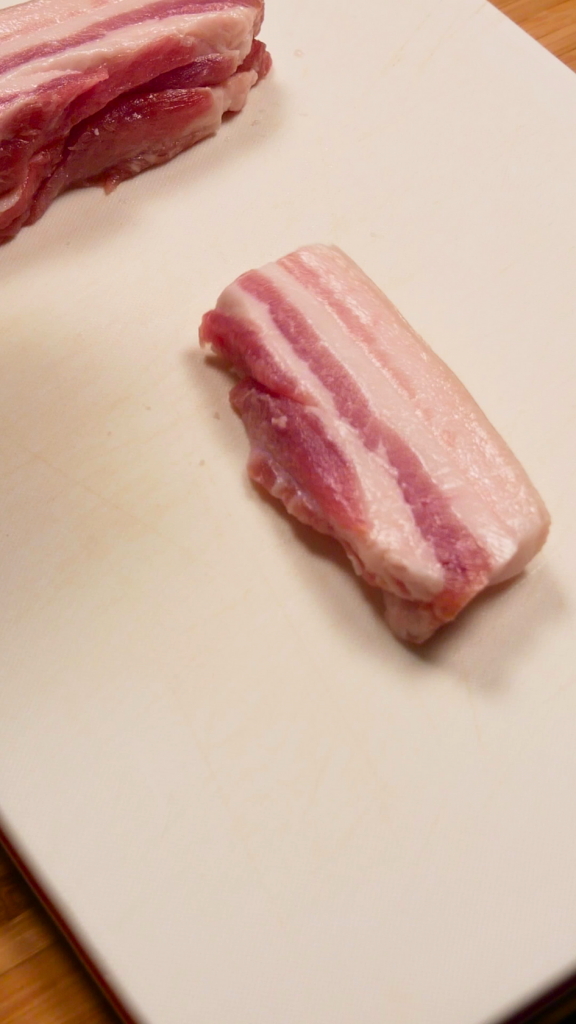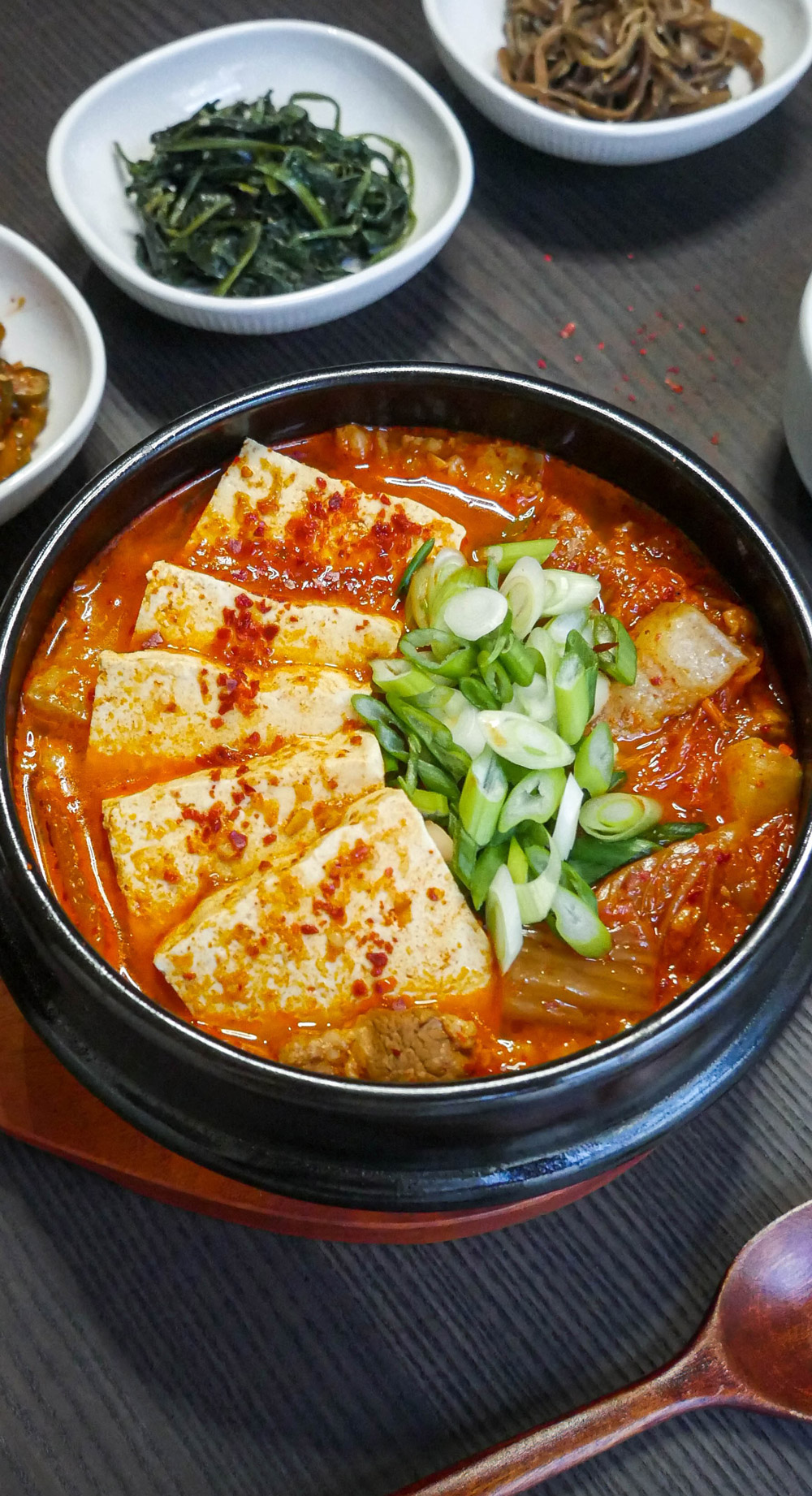Kimchi jiigae aka the Queen of all Korean stews is one of the most classic and common dishes in Korean cuisine. There are many variations to this dish – you can make it with pork belly, spare ribs, mackerel, tofu, sliced beef, seafood, and more!
Growing up, my mom would make kimchi jjigae for me at least once a week. It was a great way to use the extra sour and fermented kimchi that had been sitting in the back of the fridge and any leftover vegetables. She would use pork bones as the main protein because picking all that succulent meat around the bones was my favorite part. Pork bones add a ton of flavor but it also takes a longer time to cook and tenderize, compared to other proteins. Pork belly is a great alternative because it cooks faster while adding just as much flavor! It is pork belly after all. 🙂
If you’re looking for the perfect weeknight meal that gives comfort and warmth, Kimchi Jjigae should be your go-to dish. Try out my recipe soon and you’ll understand why Kimchi Jjigae is the Queen of all Korean stews!

What is Kimchi Jjigae?
Kimchi jjigae is a classic Korean stew that is considered the ultimate comfort food for most Korean people across the world. This warm, spicy, and savory iconic stew mainly features fatty pork meat and kimchi which are staples in Korean cuisine. Kimchi jijgae is commonly served in Korean households, together with other side dishes or ‘banchan‘. Traditionally, Korean stews were served in a huge pot at the center of the table and everyone would eat communally from the pot.
Because kimchi is such a staple food in Korean homes, Kimchi jjigae is naturally one of the most-loved and common dishes in Korean cuisine. Kimchi is an excellent ingredient for various Korean dishes, like kimchi jjigae, especially as it ages and continues to ferment.

Kimchi Jjigae Ingredients & Substitutions
Pork Belly: pork belly is the main protein in this stew and although it is one of the more popular ingredients, you can substitute it with any protein you like! Sometimes I’ll switch it up and use pork neck bones or pork ribs instead.
Water: water is used as the base of the stew.
Salted Fermented Shrimp: this is the secret ingredient to making this taste extra delicious. It’s small salted shrimp that has been fermented and when I say it’s salty, it’s REALLY salty. A little goes a long way. If you don’t have this, you can use 1/2 tablespoon of fish sauce.
Sour Kimchi: for kimchi jjigae, you want to use the most sour and fermented kimchi. It should be funky in smell and extremely sour. If you don’t have sour kimchi, you can still make kimchi jjigae by mixing it with a splash of vinegar before using it.
Coarse Gochugaru: coarse gochugaru is used to add spiciness to the stew. Feel free to adjust the amount added based on your spice level preference.
Fine Gochugaru: similar to coarse gochugaru, fine gochugaru adds spiciness but it also creates a deep red hue to the stew. You can substitute this with more coarse gochugaru or skip it.
Garlic: garlic adds a delicious garlicky flavor and aroma to the stew. Feel free to add more, but not less!
Soup Soy Sauce: soup soy sauce is optional if the kimchi jjigae is seasoned enough. Kimchi is naturally salty and if using salted fermented shrimp, you may not need to add this. Be sure to taste as you go and add if needed.
Firm Tofu: firm tofu tofu is what I used this time but you can also use soft tofu as well. Not to be confused with silken tofu, which isn’t ideal for this as the tofu is too delicate.
Scallion: scallions are added as a garnish for freshness.
Long Green Peppers: long green peppers add a subtle kick for some additional heat. It can be substituted with serrano peppers or jalapeno peppers.

How to Make Kimchi Jjigae
Kimchi Jjigae takes a little over half an hour to make. It’s relatively straightforward and easy to prepare! Follow my kimchi jjigae recipe instructions below!
Step 1: Slice the pork and boil to create the soup base.


The first step is preparing the soup base of the stew. You can do this by first cutting the pork into half-inch pieces, and then placing them in a ddukbaegi (Korean earthenware pot) or regular pot.

Next, add some water and salted fermented shrimp. Bring this to a boil and cook under medium-low fire for about 15 minutes.
Step 2: Prepare your other ingredients.

While boiling the pork, you can prepare the other ingredients. Chop the scallions and peppers into ¼ inch pieces and slice the tofu into small chunks. Set them aside.
Step 3: Add the kimchi and spices to the pork.


After 15 minutes of boiling the pork, add your sour kimchi, coarse gochugaru, fine gochugaru, and garlic. Cover and simmer for another 15 minutes. By this time, your kimchi should be softened already.
Step 4: Season your stew and add the tofu.

Once the 15 minutes have passed, taste your stew and season accordingly. Depending on how salty your kimchi is, you may need to add some soy sauce.
When you’re satisfied with how your stew tastes, add the chunks of tofu on top. Keep in mind that tofu is delicate. So don’t mix your stew around after adding the tofu.
Step 5: Garnish and serve hot.


Garnish with scallions and peppers and simmer for another 30 seconds. Now your Kimchi Jjigae is ready! Serve hot with a bowl of fresh white rice and enjoy!
Cooking Tips for Kimchi Jjigae
- Kimchi jiigae is traditionally prepared and served in a ddukbaegi (Korean earthenware pot) and while it isn’t essential to make this recipe, using it will keep the stew hot for a long time.
- You can substitute the pork belly with pork shoulder, pork neck bones, pork ribs, or any other protein you like!
- If you don’t have sour kimchi, mix it with a splash of vinegar before using it.
- Tofu should be added after the seasoning is complete. It is very delicate and will break apart so you want to avoid mixing the stew after the tofu is added.
- The stew tastes better as it sits so this will be even more delicious the next day as leftovers!
Frequently Asked Questions
What is a ‘ddukbaegi’ and do I need to use it?
‘Ddukbaegi’ is a Korean earthenware pot commonly used to serve stews like kimchi jjigae. It helps to retain heat and keep food warmer for longer which is ideal for recipes like this. It’s not necessary to use one so you don’t need to go out of your way to purchase it unless you plan on using it regularly. A regular pot would work just fine!
Can I make Kimchi Jjigae vegetarian-friendly?
Yes, absolutely! You can substitute the pork and use a dashi broth or mushroom broth. Simply simmer dashi or mushrooms for 15 minutes to make the broth. This recipe uses salted fermented shrimp so you can substitute that with soup soy sauce or a pinch of regular salt. Feel free to add your favorite vegetables like enoki mushrooms, zucchini, and more!
What if I don’t have sour kimchi?
Sour and well-fermented kimchi are essential for kimchi jjigae however, you can still make a delicious jjigae without it! Simply mix a splash of vinegar with the kimchi and this will mimic the sourness of fermented kimchi.
Is Kimchi Jjigae spicy?
Yes! Kimchi jjigae is typically prepared spicy due to the kimchi and gochugaru. However, feel free to adjust the spiciness by reducing the amount of gochugaru added.
How do I store leftover Kimchi Jjigae?
Kimchi jjigae should be stored in an airtight container in the fridge for up to 3 days. It’ll actually taste even more delicious as the flavors will deepen over time. Reheat over the stove top and if needed, add a splash of water to loosen it up.
Looking for more easy and delicious Korean-inspired recipes?
- Beef Dolsot Bibimbap – if you’re looking for another classic favorite, this is a must-try recipe! Delicious marinated beef served with rice and various vegetables in a hot stone bowl makes it hard to resist.
- Korean Vegetable Pancakes – this Korean vegetable pancake is a staple dish in Korean cuisine. Made with potatoes and zucchini, this is a delicious blend of textures and flavors!
- Soy Marinated Raw Crab – this Korean delicacy is made of raw crabs cured in a delicious soy sauce-based marinade. The tender yet subtly sweet meat of the crab is beautifully complemented by the rich and savory flavors of the marinade, making it perfect with a bowl of rice.
- Bibim Myeon – aka Korean Spicy Cold Noodles is a spicy, sweet, and tangy cold noodle dish that’s perfect for when you’re craving a refreshing and nourishing meal. Not only is it absolutely delicious, it’s incredibly easy to make!
- Korean Pork Bone Soup – also known as ‘gamja tang’, this is the epitome of Korean comfort food. It’s made of succulent tender pork bones and a wide variety of vegetables served in a rich and hearty soup.

Kimchi Jjigae
Ingredients
- 5 oz pork belly
- 2.5 cups water
- 1/2 tbsp salted fermented shrimp substitute with 1/2 tablespoon of fish sauce
- 2 cups sour kimchi chopped
- 1 tbsp coarse gochugaru red pepper powder
- 1/2 tbsp fine gochugaru red pepper powder
- 1 tbsp garlic minced
- 1/2 block firm tofu sliced, substitute with soft tofu (not silken)
- 1/2 tbsp soup soy sauce optional, to taste
- 1 stalk scallion chopped
- 1 long long green peppers chopped, substitute with serrano or jalapeno peppers
Instructions
- Slice the pork belly into 1/2 inch thick pieces.
- In a ddukbaegi (earthenware pot) or a regular pot, add the pork, water, and salted fermented shrimp. Bring to a boil and cook for 15 minutes over medium-low heat.
- After 15 minutes, add the kimchi, coarse gochugaru, fine gochugaru, and garlic. Let the stew simmer for another 15 minutes until the kimchi has softened. Taste for seasoning and add soup soy sauce if needed. Depending on how salty your kimchi is, you may or may not need to add this so be sure to taste first!
- Once the seasoning is complete, add the tofu on top. Tofu is very delicate so avoid mixing the stew after you add it in.
- Garnish with the scallions and peppers and let simmer for another 30 seconds. Serve hot with a fresh bowl of rice and enjoy!
Notes
- While a ddukbaegi (Korean earthenware pot) isn’t essential to make this recipe, using it will keep the stew hot for a long period of time.
- You can substitute the pork belly with pork shoulder or pork bones (ribs, neck bone)
- If you don’t have salted fermented shrimp, you can substitute with 1/2 tablespoon of fish sauce.
- Every kimchi is made differently so the salt levels will vary. Be sure to taste as you go along and add the soup soy sauce to taste.
- Tofu should be added after the seasoning is complete. It is very delicate and will break apart so you want to avoid mixing the stew after the tofu is added.
- The stew tastes better as it sits so this will be even more delicious the next day as left overs.
- f you don’t have old kimchi and you don’t have time to wait for it to turn sour, add a small amount of vinegar before using it.
Pin & save this recipe for later!

